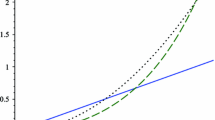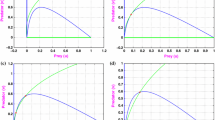Abstract
A two-species predator–prey reaction diffusion model where additional food was provided to the predator has been considered in the presence of both self- and cross-diffusion terms in a two-dimensional space. Importance of self- and cross-diffusion terms are discussed ecologically. Linear stability analysis has been done to determine the Turing instability region of the parameter space. Impacts of the cross-diffusion term on the stability behaviour are discussed. Using weak nonlinear analysis, the amplitude equations has been formulated to predict the stability of hexagonal, stripes and their mixture patterns near the Turing thresholds analytically. Finite difference method has been used for numerical simulations of the model under no-flux boundary conditions. Numerical simulation results are in good agreement with the theoretical predictions of patterns near the Turing threshold using amplitude equations. Additional food can play a significant role in pattern forming instabilities because near the Turing thresholds small fluctuation of additional food parameter can produce a wide variety of Turing patterns.










Similar content being viewed by others
References
S N Chowdhury, J Banerjee, M Perc and D Ghosh, J. Theor. Biol. 564, 111446 (2023)
S N Chowdhury, S Kundu, J Banerjee, M Perc and D Ghosh, J. Theor. Biol. 518, 110606 (2021)
S N Chowdhury, S Kundu, M Perc and D Ghosh, Proc. R. Soc. A 477(2252), 20210397 (2021)
M C Cross and P C Hohenberg, Rev. Mod. Phys. 65(3), 851 (1993)
Y Xu, W Jin and J Ma, Int. J. Mod. Phys. B 29(23), 1550164 (2015)
W Wang, L Zhang, H Wang and Z Li, Ecol. Model. 221(2), 130 (2010)
H Teimouri and A B Kolomeisky, J. Phys. A: Math. Theor. 49(48), 483001 (2016)
G Q Sun, Z Jin, L Li, M Haque and B L Li, Nonlinear Dyn. 69(4), 1631 (2012)
W Wang, Y Lin, L Zhang, F Rao and Y Tan, Commun. Nonlinear Sci. Numer. Simul. 16(4), 2006 (2011)
J Chattopadhyay and P K Tapaswi, Acta Appl. Math. 48(1), 1 (1997)
J D Murray, Mathematical biology II: Spatial models and biomedical applications (Springer, New York, 2001) Vol. 3
E H Kerner, Bull. Math. Biophys. 21(2), 217 (1959)
N Shigesada, K Kawasaki and E Teramoto, J. Theor. Biol. 79(1), 83 (1979)
L N Guin, Math. Comput. Simul. 109, 174 (2015)
S Kumari, S K Tiwari and R K Upadhyay, Math. Comput. Simul. 202, 246 (2022)
S Ghorai and S Poria, Chaos Solitons Fractals 85, 57 (2016)
C Li, Chaos Solitons Fractals 99, 226 (2017)
X Tang and Y Song, Nonlinear Anal. Real World Appl. 24, 36 (2015)
G Q Sun, Z Jin, Q X Liu and L Li, Chin. Phys. B 17(11), 3936 (2008)
X Tang, Y Song and T Zhang, Nonlinear Dyn. 86(1), 73 (2016)
S Ghorai and S Poria, Nonlinear Dyn. 87(4), 2715 (2017)
Y Nec and A A Nepomnyashchy, J. Phys. A: Math. Theor. 40(49), 14687 (2007)
Y Nec and A A Nepomnyashchy, J. Phys. A: Math. Theor. 41(38), 385101 (2008)
M W Sabelis, P C J Van Rijn, IOBC WPRS Bulletin 29(4), 195 (2006)
P D N Srinivasu and B S R V Prasad, J. Math. Biol. 60(4), 591 (2010)
K P Das, N Bairagi and P Sen, Int. J. Bifurc. Chaos 26(09), 1650147 (2016)
A Gupta, A Kumar and B Dubey, Int. J. Biomath. 15(08), 22550060 (2022)
S Chakraborty, P K Tiwari, S K Sasmal, S Biswas, S Bhattacharya and J Chattopadhyay, Appl. Math. Model. 47, 128 (2017)
S Ghorai and S Poria, Chaos Solitons Fractals 103, 68 (2017)
S Ciliberto, P Coullet, J Lega, E Pampaloni and C Perez-Garcia, Phys. Rev. Lett. 65(19), 2370 (1990)
W Wang, Y. Lin, F Rao, L Zhang and Y Tan, J. Stat. Mech.: Theory Exp. 2010(11), P11036 (2010)
J Ma, Y Xu, G Ren and C Wang, Nonlinear Dyn. 84(2), 497 (2016)
V Vitagliano, Pure Appl. Chem. 63(10), 1441 (1991)
S Yuan, C Xu and T Zhang, Chaos 23(3), 033102 (2013)
B Pena and C Perez-Garcia, Europhys. Lett. 51(3), 300 (2000)
B Pena and C Perez-Garcia, Phys. Rev. E 64(5), 056213 (2001)
S N Chowdhury and D Ghosh, Eur. Phys. J. Spec. Top. 229(6–7), 1299 (2021)
Acknowledgements
The authors are thankful to the Editor in Chief and anonymous reviewers for their valuable comments and suggestions. The authors are thankful to the Editor in chief and anonymous reviewers for their valuable comments and suggestions.
Author information
Authors and Affiliations
Corresponding author
Rights and permissions
About this article
Cite this article
Ghorai, S., Umut, O. & Poria, S. Analysis of patterns in an additional food-provided predator–prey reaction diffusion model using amplitude equations. Pramana - J Phys 97, 200 (2023). https://doi.org/10.1007/s12043-023-02679-x
Received:
Revised:
Accepted:
Published:
DOI: https://doi.org/10.1007/s12043-023-02679-x




